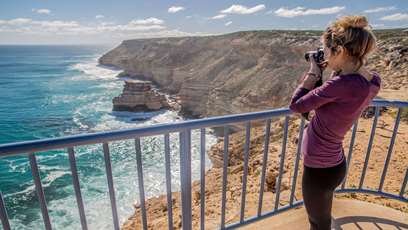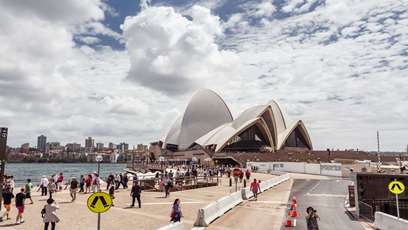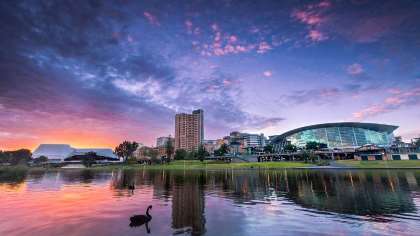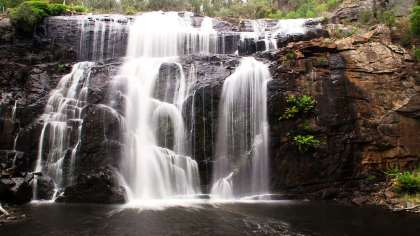9 top tips for capturing the best travel photos
Technology has only increased our thirst for photography. The emergence of smartphones and digital cameras – as well as image-focussed social media channels – means being behind the lens is easier and more rewarding than ever.

And with BIG4 Holiday Parks at the heart of so many glorious Australian locations there’s even more reason to click away when on the road.
While technological advances have made photography simpler, your camera or phone can’t do all the work for you. So we’re arming you with a selection of travel photography tips to help you capture the best images possible.
1. Get to know your camera in advance
You’ve just bought a new camera – that’s great! Well, that is unless you’re going on holiday tomorrow. If you’re not acquainted with your new toy well before departure you might find yourself wasting precious time flicking through manuals and being frustrated by settings when you should be enjoying yourself. Even if you spend only a short amount of time getting a feel for your camera before you head off, it's better than nothing.
2. Do your research
Scenario: You spy a breathtaking rock formation or towering waterfall while navigating around BIG4.com.au and decide you want to photograph that particular scene for yourself. You arrive at your prized vantage point and gasp in horror – the image you’ve gazed at doesn’t contain busloads of tourists!
Solution: Do your research to avoid peak times if photographing at popular sites. Or ask a staff member at your BIG4 Holiday Park for advice – they may reveal an alternative vantage point to snap away at your treasured subject.

You're not the only one: rock up to the Sydney Opera House during the middle of the day and expect to be joined by a throng of tourists.
3. Think about your timing
Image quality varies considerably depending on when you photograph. Early risers are consistently rewarded: cue jaw-dropping sunrises and crowd-free spaces. Conversely, patiently waiting to shoot a blazing sky at sunset can be equally gratifying.
Yet again, ask a local, or research the optimum time to capture landmark sites. Standley Chasm near Alice Springs is a good example of an attraction that rewards savvy photographers (for the record, it’s best photographed around midday).
Also chat to other park guests – they may help to unearth a secret beach or hidden waterfall to click away at.

Sometimes it pays to miss happy hour. Shooting at sunset (or sunrise) consistently rewards photographers, evidenced by this colourful pic of the Adelaide skyline.
4. Composition tip no.1
While this is not a technical photography guide, we have a couple of simple composition tips to make your photos more pleasing to the eye.
Consider adopting the ‘rule of thirds’ principle when composing an image. In short, this principle suggests that you divide the camera frame into thirds and place the main element/s of the shot at the ‘intersection’ of those lines (as opposed to dead centre). This is a highly respected technique that enhances interest and makes each image more balanced. Most cameras and smartphones are equipped with a grid function that helps you to follow this principle.

This photo of the famous Twelve Apostles demonstrates the rule of thirds principle. Note how the image's main elements (rock, sun) are placed at the intersection of the grid lines.
5. Composition tip no.2
Give thought to the key element/s of your image and what you’re trying to achieve. For example, photographing friends or family requires versatile thinking. Sometimes it pays to ‘fill the frame’ (take a close up) to best capture a beaming smile and portray your subject’s excitement. However, if you’re near an iconic sight consider giving more weight to the surrounds to highlight the destination’s significance.
Similarly, don’t shy from ‘negative space’, i.e. a backdrop of a bright blue ocean. If negative space helps to ‘bring out’ the main subject of your photo, include it.
If photographing from a lookout or at a crowded area (where people are not your subject matter), identify a key element. Otherwise the image may be too ‘busy’, boring, or inadequately convey the scene.
Despite all this, don’t let hard-and-fast composition rules override your instinct. As the saying goes, rules are meant to be broken!

This image perfectly illustrates the girl's happiness (even if posed). This look of joy is enhanced by the dead space: the background doesn't 'steal' your eye from the child's smile.
6. Consider the emotion of the scene
When photographing, give thought to the vibe or emotion of the subject you’re portraying. Is it the thrill of the rollercoaster at a Gold Coast theme park, the seclusion of a Tasmanian beach, or the vast expanse of Australian outback? Whatever it is, aim to capture it in your image. Considering the distance range of your image (depth of field) and the placement of subjects (focal point) is a good starting point.

The vast expanses of South Australia's Lake Gairdner are adequately highlighted by placing the subject in a non-dominant position and having a deep depth of field.
7. Don’t be afraid to experiment
For those who like to be creative, experiment to your heart’s content! Digital technology means photographic experimentation does not have to equate to churning through rolls and rolls of expensive film. Nowadays, if your creative efforts don’t work out, simply delete the image and try again.

There's more than one way to photograph the Sydney Harbour Bridge. Be creative when shooting popular attractions.
8. Charge your battery
It’s obvious advice but it can’t be stressed enough: always charge your camera battery or phone before you head out to shoot. You’ll never forgive yourself if you miss that once-in-a-lifetime shot as a result of a dead battery.

Warren could've snapped the bewitching sight of MacKenzie Falls in Victoria’s Grampians National Park if only he had remembered the golden rule: always charge your camera.
9. Enjoy the moment
To finish with, remember this understated tip: don’t let the process consume you. Enjoy the moment and never let photography detract from your holiday experience. If you’re stressing about camera settings or trying to perfect a shot you may miss the moment altogether. Take time to appreciate what’s in front of you.

While Denise was busy playing with her camera and being frustrated by its settings, the whale finally made an appearance.
Source:
Reproduced with the permission of BIG4 Holiday Parks. This article first appeared on BIG4.com.au and was republished with permission.
Important:
Any information provided by the author detailed above is separate and external to our business and our Licensee. Neither our business, nor our Licensee take any responsibility for their action or any service they provide.
Any links have been provided with permission for information purposes only and will take you to external websites, which are not connected to our company in any way. Note: Our company does not endorse and is not responsible for the accuracy of the contents/information contained within the linked site(s) accessible from this page.

